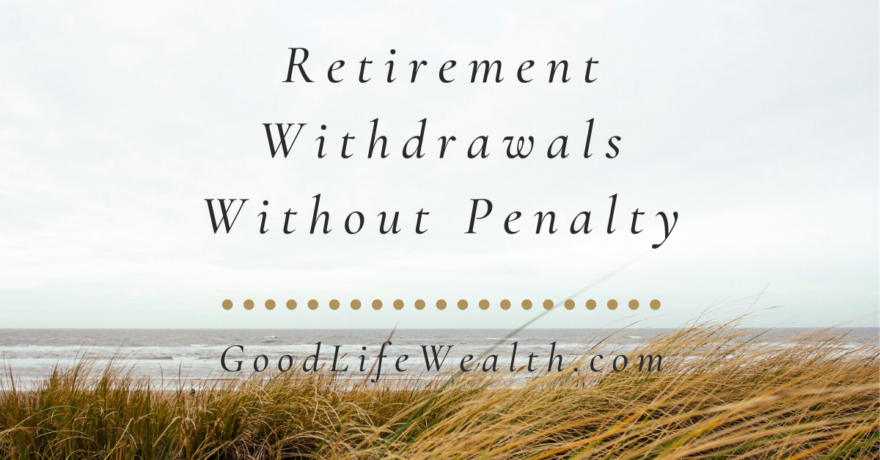Today, we are starting a five-part series to look at creating retirement income. There are various different approaches you can take when it is time to retire and shift from accumulation to taking withdrawals from your 401(k), IRA, or other investment accounts. It is important to know the Pros and Cons of different approaches and to understand, especially, how they are designed to weather market volatility.
In upcoming posts, we will evaluate SPIAs, the 4% rule, a Guardrails Approach, and 5-Year Buckets. Before you retire, I want to discuss these with you and set up an income plan that is going to make the most sense for you. Today, let’s start with defining the challenges of creating retirement income.
Sequence of Returns Risk
During accumulation, market volatility is not such a bad thing. If you are contributing regularly to a 401(k) and the market has a temporary Bear Market, it is okay. All that matters is your long-term average return. If you invest over 30-40 years, you have historically averaged a return of 8-10 percent in the market. Through Dollar Cost Averaging, you know that you are buying shares of your funds at a more attractive price during a drop.
Unfortunately, market volatility is a big problem when you are retired and taking money out of a portfolio. You calculated your needs and planned to take a fixed amount of money out of your portfolio. If the market averages 8% returns, can you withdraw 8%? That should work, right?
Let’s look at an example. You have a $1 million portfolio, you want to take $80,000 a year in withdrawals. Imagine you retired in 2000, having reached your goal of having $1 million! Here’s what your first three years of retirement might have looked like, with $80,000 annual withdrawals:
- Start at $1,000,000, 9% market loss = $830,000 ending value
- Year 2: start at $830,000, 12% market loss = $650,400 ending value
- Year 3: start at $650,400, 22% market loss = $427,312 ending value
This would blow up your portfolio and now, your $80,000 withdrawal would be almost 20% of your remaining funds. This is Sequence of Returns Risk: the order of returns matters when you are taking income. If you had retired 10 years before these three bad years, you might have been okay, because your portfolio would have grown for a number of years.
Because a retiree does not know the short-term performance of the stock market, we have to take much smaller withdrawals than the historical averages. It’s not just the long-term average which matters. Losses early in your retirement can wreck your income plan.
Longevity Risk
The next big risk for retirement income is longevity. We don’t know how long to plan for. Some people will have a short retirement of less than 10 years. Others will retire at 60 and live for another 40 years. If we take out too much, too early, we risk running out of funds at the worst possible time. There is tremendous poverty in Americans over the age of 80. They didn’t have enough assets and ran out of money. Then they end up having to spend down all their assets to qualify for Medicaid. It’s not a pretty picture.
And for you macho men who intend to die with your boots on – Great. You may wipe out all your money with your final expenses and leave your spouse impoverished. She will probably outlive you by 5-10 years. That’s why 80% of the residents in nursing homes are women. You need to plan better – not for you, but for her.
Read more: 7 Ways for Women to Not Outlive Their Money
We plan for a retirement of 30 years for couples. There’s a good chance that one or both of you will live for 25-30 years if you are retiring by age 65. There are different approaches to dealing with longevity risk, and we will be talking about this more in the upcoming articles.
Inflation Risk
Longevity brings up a related problem, Inflation Risk. At 3% inflation, your cost of living will double in 24 years. If you need $50,000 a year now, you might need $100,000 later, to maintain the same standard of living.
A good retirement income plan will address inflation, as this is a reality. Luckily, we have not had much inflation in recent decades, so retirees have not been feeling much pressure. In fact, most of my clients who start a monthly withdrawal plan, have not increased their payments even after 5 or 10 years. They get used to their budget and make it work. Retirement spending often follows a “smile” pattern. It starts high at the beginning of retirement, as you finally have time for the travel and hobbies you’ve always wanted. Spending typically slows in your later seventies and into your eighties, but increases towards the end of retirement with increased health care and assistance costs.
When we talk about a 4% Real Rate, that means that you would start at 4% but then increase it every year for inflation. A first year withdrawal of $40,000 would step up to $41,200 in year two, with 3% inflation. After 30 years (at 3% inflation), your withdrawal rate would be over $94,000. So, when we talk about a 4% withdrawal rate, realize that it is not as conservative as it sounds. Even at a low 3% inflation rate, that works out to $1,903,016 in withdrawals over 30 years. It’s a lot more than if you just were thinking $40,000 times 30 years ($1.2 million).
Periods with high inflation require starting with a lower withdrawal rate. Periods with low inflation enable retirees to take a higher initial withdrawal amount. Since we don’t know future inflation, most safe withdrawal approaches are built based on the worst historical case.
Invest for Total Return
There is one thing which all of our retirement income approaches agree upon: Invest for Total Return, not Income. This is counter-intuitive for many retirees. They want to find high yielding bonds, stocks, and funds. Then, they can generate withdrawal income and avoid selling shares.
It sounds like it would be a rational approach. If you want a 5% withdrawal rate, just buy stocks, bonds, and funds that have a 5% or higher dividend yield. Unfortunately, this often doesn’t work as planned or hoped!
Over the years, I’ve invested in everything high yield: dividend stocks, preferred stocks, high yield bonds, Real Estate Investment Trusts (REITs), Master Limited Partnerships (MLPs), Closed End Funds, etc. They can have a small place in a portfolio, but they are no magic bullet.
Problems with Income Investing
- Value Trap. Some stocks have high yields because they have no growth. Then if they cut their dividends, shares plummet. Buy the highest dividend payouts and your overall return is often less than the yield and the share price goes no where. (Ask me about the AT&T shares I’ve held since 2009 and are down 14%.)
- Default risk. Many high yield investments are from highly levered companies with substantial risk of bankruptcy. Having 5% upside and 100% downside on a high yield bond or preferred stock is a lousy scenario. When you do have the occasional loss, it will be greater than many years of your income.
- Poor diversification. High yield investments are not equally present in all sectors of the economy. Often, an income portfolio ends up looking like a bunch of the worst banks, energy companies, and odd-ball entities. These are often very low quality investments.
Instead of getting the steady paycheck you wanted, an income portfolio often does poorly. When your income portfolio is down in a year when the S&P is up 10-20%, believe me, you will be ready to throw in the towel on this approach. Save yourself this agony and invest for total return. Total return means you want capital gains (price appreciation) and income.
For investors in retirement accounts, there is no tax difference between taking a distribution from dividends versus selling your shares. So, stop thinking that you need to only take income from your portfolio. What you want is to have a diversified portfolio and a good long-term rate of return. Then, just make sure you are able to weather market volatility along the way.
Read more: Avoiding The High Yield Trap
Ahead in the Series
Each of the retirement income approaches we will discuss have their own Pros and Cons. We will address each through looking at how they address the risks facing retirees: Sequence of Returns Risk, Longevity Risk, and Inflation Risk. And I’ll have recommendations for which may make the most sense for you. In the next four posts, I’ll be explaining SPIAs, the 4% Rule, a Guardrail Approach, and 5-Year Buckets.
Even if you aren’t near retirement, I think it’s vitally important to understand creating retirement income. Retirement income establishes your finish line and therefore your savings goals. If you are planning on a 4% withdrawal rate, you need $1 million for every $40,000 a year in retirement spending. Looking at your monthly budget, you can calculate how much you will need in your nest egg. Then we can have a concrete plan for how much to invest and how we will get there. Thanks for reading!













